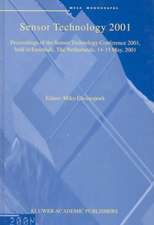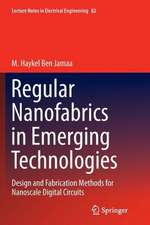Mechanical Microsensors: Microtechnology and MEMS
Autor M. Elwenspoek, R. Wiegerinken Limba Engleză Paperback – 7 dec 2010
| Toate formatele și edițiile | Preț | Express |
|---|---|---|
| Paperback (1) | 1217.41 lei 6-8 săpt. | |
| Springer Berlin, Heidelberg – 7 dec 2010 | 1217.41 lei 6-8 săpt. | |
| Hardback (1) | 1223.43 lei 6-8 săpt. | |
| Springer Berlin, Heidelberg – 27 noi 2000 | 1223.43 lei 6-8 săpt. |
Din seria Microtechnology and MEMS
- 18%
 Preț: 969.44 lei
Preț: 969.44 lei - 18%
 Preț: 947.04 lei
Preț: 947.04 lei - 18%
 Preț: 950.21 lei
Preț: 950.21 lei - 15%
 Preț: 638.24 lei
Preț: 638.24 lei - 18%
 Preț: 949.55 lei
Preț: 949.55 lei - 18%
 Preț: 948.16 lei
Preț: 948.16 lei - 18%
 Preț: 948.29 lei
Preț: 948.29 lei - 15%
 Preț: 641.38 lei
Preț: 641.38 lei - 18%
 Preț: 948.61 lei
Preț: 948.61 lei - 15%
 Preț: 649.06 lei
Preț: 649.06 lei - 15%
 Preț: 638.43 lei
Preț: 638.43 lei - 15%
 Preț: 637.59 lei
Preț: 637.59 lei - 15%
 Preț: 646.62 lei
Preț: 646.62 lei - 24%
 Preț: 800.57 lei
Preț: 800.57 lei - 15%
 Preț: 640.88 lei
Preț: 640.88 lei - 18%
 Preț: 953.65 lei
Preț: 953.65 lei - 18%
 Preț: 952.09 lei
Preț: 952.09 lei - 18%
 Preț: 954.62 lei
Preț: 954.62 lei - 18%
 Preț: 948.79 lei
Preț: 948.79 lei - 18%
 Preț: 1007.35 lei
Preț: 1007.35 lei - 15%
 Preț: 642.51 lei
Preț: 642.51 lei - 18%
 Preț: 1007.35 lei
Preț: 1007.35 lei - 18%
 Preț: 1002.75 lei
Preț: 1002.75 lei
Preț: 1217.41 lei
Preț vechi: 1484.65 lei
-18% Nou
Puncte Express: 1826
Preț estimativ în valută:
232.96€ • 249.11$ • 194.23£
232.96€ • 249.11$ • 194.23£
Carte tipărită la comandă
Livrare economică 17 aprilie-01 mai
Preluare comenzi: 021 569.72.76
Specificații
ISBN-13: 9783642087066
ISBN-10: 364208706X
Pagini: 308
Ilustrații: X, 295 p.
Dimensiuni: 155 x 235 x 16 mm
Greutate: 0.44 kg
Ediția:Softcover reprint of hardcover 1st ed. 2001
Editura: Springer Berlin, Heidelberg
Colecția Springer
Seria Microtechnology and MEMS
Locul publicării:Berlin, Heidelberg, Germany
ISBN-10: 364208706X
Pagini: 308
Ilustrații: X, 295 p.
Dimensiuni: 155 x 235 x 16 mm
Greutate: 0.44 kg
Ediția:Softcover reprint of hardcover 1st ed. 2001
Editura: Springer Berlin, Heidelberg
Colecția Springer
Seria Microtechnology and MEMS
Locul publicării:Berlin, Heidelberg, Germany
Public țintă
ResearchCuprins
1. Introduction.- 2. MEMS.- 2.1 Miniaturisation and Systems.- 2.2 Examples for MEMS.- 2.3 Small and Large: Scaling.- 2.4 Available Fabrication Technology.- 3. Introduction into Silicon Micromachining.- 3.1 Photolithography.- 3.2 Thin Film Deposition and Doping.- 3.3 Wet Chemical Etching.- 3.4 Waferbonding.- 3.5 Plasma Etching.- 3.6 Surface Micromachining.- 4. Mechanics of Membranes and Beams.- 4.1 Dynamics of the Mass Spring System.- 4.2 Strings.- 4.3 Beams.- 4.4 Diaphragms and Membranes.- 5. Principles of Measuring Mechanical Quantities: Transduction of Deformation.- 5.1 Metal Strain Gauges.- 5.2 Semiconductor Strain Gauges.- 5.3 Capacitive Transducers.- 6. Force and Pressure Sensors.- 6.1 Force Sensors.- 6.1.1 Load Cells.- 6.2 Pressure Sensors.- 7. Acceleration and Angular Rate Sensors.- 7.1 Acceleration Sensors.- 7.2 Angular Rate Sensors.- 8. Flow sensors.- 8.1 The Laminar Boundary Layer.- 8.2 Heat Transport in the Limit of Very Small Reynolds Numbers.- 8.3 Thermal Flow Sensors.- 8.4 Skin Friction Sensors.- 8.5 “Dry Fluid Flow” Sensors.- 8.6 “Wet Fluid Flow” Sensors.- 9. Resonant Sensors.- 9.1 Basic Principles and Physics.- 9.2 Excitation and Detection Mechanisms.- 9.3 Examples and Applications.- 10. Electronic Interfacing.- 10.1 Piezoresistive Sensors.- 10.2 Capacitive Sensors.- 10.3 Resonant Sensors.- 11. Packaging.- 11.1 Packaging Techniques.- 11.2 Stress Reduction.- 11.3 Pressure Sensors.- 11.4 Inertial Sensors.- 11.5 Thermal Flow Sensors.- References.
Recenzii
"Mechanical Microsensors provides a comprehensive description of the various design techniques required for silicon micromachining of sensors. This is a very well written book which has a pleasant balance of mathematical, physics and engineering principles, that make this book suitable for physicists, chemistry, electrical and mechanical engineers."
--SENSOR REVIEW
"Of particular value is the fact that the authors go further than the description of the silicon sensor elements and also present solutions on how to interface these sensors to the surrounding world - electronically in the chapter on 'Electronic Interfacing' as well as physically in the chapter on 'Packaging'. To summarize, this textbook gives a comprehensive overview of mechanical microsensors which is especially well suited for students in courses on mechanical microsensors, but is also valuable for people in research and industry with an interest in this exciting and growing field."
-MEASUREMENT SCIENCE AND TECHNOLOGY
--SENSOR REVIEW
"Of particular value is the fact that the authors go further than the description of the silicon sensor elements and also present solutions on how to interface these sensors to the surrounding world - electronically in the chapter on 'Electronic Interfacing' as well as physically in the chapter on 'Packaging'. To summarize, this textbook gives a comprehensive overview of mechanical microsensors which is especially well suited for students in courses on mechanical microsensors, but is also valuable for people in research and industry with an interest in this exciting and growing field."
-MEASUREMENT SCIENCE AND TECHNOLOGY
Textul de pe ultima copertă
Fabrication technologies related to those which are exploited for the fabrication of integrated circuits can be used to machine mechanical structures with minimum feature sizes in the range of micrometers. The mechanical machining of silicon based on IC-technologies is known as micromachining, and the systems made by micromachining are called MEMS (microelectromechanical systems). The present book describes how to use this technology to fabricate sensors of miniature size for mechanical quantities, such as pressure, force, flow and acceleration. The book includes a chapter with a comprehensive description of the relevant micromachining processes, and an introduction to MEMS, a field much broader than just microsensors. Most of these sensors rely on a deformation of the mechanical construction by an external load, and on a transduction mechanism to convert the deformation into a mechanical signal. The fundamental mechanics and electromechanics required for the understanding and the design of mechanical microsensors are described on a level accessible to engineers of all disciplines. Students in engineering sciences from the third year on should be able to benefit from this description. The most important mechanical sensors are described and discussed in detail with respect to fabrication issues, function and performance. Special emphasis is given to pressure sensors, force sensors, accelerometers, gyroscopes and flow sensors. Electronic interfacing, and a discussion of electronic circuits used for the sensors is also included. Finally the problem of packaging is addressed.
Caracteristici
Gives an overview of the physics necessary to understand, design and fabricate mechanical microsensors Provides a guide to the relevant literature Discusses the advantages and limitations of microtechnology Includes supplementary material: sn.pub/extras




















